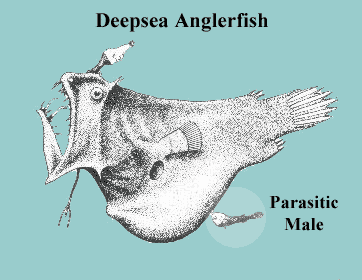
Most fish are oviparous, although ovoviparity and viviparity are also well represented. Parental care may occur in oviparous fishes but is quite variable, with many fishes scattering eggs and displaying no care whatsoever for offspring. Some, however, provide care by building and guarding nests of various construction (e.g. sunfishes: clearings in substrate, killifish: bits of vegetation, fighting fish: saliva bubbles) for the eggs and larvae, while others provide protection within the parents body (e.g. tilapia: mouth, seahorses: pouch). When parental care is provided, it is of short duration. In ovoviparous (e.g. guppies and their relatives) and viviparous (e.g. many sharks) fishes, care is provided by incubation inside the mother's body. Fecundity varies greatly and is somewhat related to parental care, with some egg scatters producing thousands of eggs and viviparous fishes producing only a few offspring.
Oviparity requires external fertilization and this means the males and females must be synchronized to be physically and behaviorally ready to spawn at the same time. Most, but not all, temperate zone fishes spawn once a year. Spawning is timed by photoperiod and triggered by temperature. In spring spawning fishes, increasing day length after the winter solstice is perceived through the eyes and translated through the brain/hypothalamus/pituitary axis to produce increasing gonadotropins in the bloodstream. These hormones stimulate oogenesis and spermatogenesis in the gonads. As they ripen, the gonads produce sex steroid hormones that stimulate secondary sex characteristics such as spawning tubercles and kypes, as well as spawning behavior. The pineal gland may also play a role in the interpretation of photoperiod. As spawning time approaches, the ovaries and testes are fully functional and the fish have migrated to the spawning grounds. When the water temperature rises (in spring spawners) to the triggering point, spawning behavior is initiated and reinforced by reciprocal behavioral cues in the opposite sex. Any nest building ensues and the eggs and sperm are released.
|
|
Fish are more sexually "plastic" than mammals. In other words, mammals are almost always clearly male or female and an individual remains that way throughout its life. Any departure from this is a rare anomaly. This is not so in fish. Hermaphrodatism is not uncommon and other alternative sexual strategies, such as parthenogenesis and hybridogenesis, are known. Hermaphrodatism may be synchronous (rare) where an individual has functional ovaries and testes at the same time, or more commonly, consecutive where it is first functionally one sex and then sex reverses to the other. Consecutive hermaphrodites are usually a female first (protogynous), but protandrous (male first) hermaphrodites are also known. An example of synchronous hermaphrodatism occurs in the sea bass family (Serranidae) where at least one species is known to take turns with its mate during spawning, first releasing sperm and then releasing eggs. Self-fertilization, which would be theoretically possible, does not occur. Protogynous hermaphrodatism is common among reef fishes, such as wrasses (Labridae), and typically has a behavioral cue. A dominant (alpha) male leads a "harem" of females. When the male is removed the next most dominant fish (beta female) reverses sex and fills the role of the missing fish.
Parthenogenesis was first reported from a Mexican molly (Poeciliidae), but occurs in other species, as well. This life cycle in which an individual genome is essentially cloned into an all female race is believed to have originated as a hybrid of two closely related species. Hybridogenesis is also known from the poeciliids and differs from parthenogenesis in that the male chromosomes are incorporated into the offspring, but the eggs lack the male component. The result is again an all female race, but while the individuals are not clones (male's genome is expressed) the same female genome is passed on in every egg with no recombination with the male chromosomes. It is like a population of the same female clones mating with a variety of males every reproductive cycle.
 |
While not an alteration of standard gender determination, a deep-sea angler fish has a unique reproductive strategy. Fertilized eggs develop into larval males and females. The females develop into normal (though weird looking) free-living fish like their mother. The males on the other hand, must quickly find a larger female and attach themselves, as they are not capable of a free-living existence. Males that attach to females become parasites that depend on the females for their bodily needs [ha]. Most of the organ structures of the males (except testes!) atrophy. A female will carry around one or more males, whose only function in life is to release sperm when the female releases eggs.
Navigation Hint: Press "Alt" and right or left keyboard arrows to move forward and back.